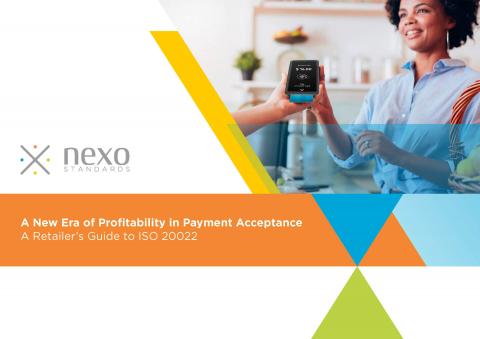
30 June 2017
Global standards in payment acceptance have arrived. How will the world benefit?
After four years of cross-industry collaboration, an open and unified global payments acceptance ecosystem has arrived, and is already delivering serious benefits for stakeholders everywhere.
It is an inescapable truth that the business of establishing open and international standards for payment acceptance takes both time and effort. The industry’s breadth of stakeholders, including merchants, card schemes, acquirers, payment service providers (PSPs) and vendors, are unaccustomed to working hand-in-hand. Happily, the members of nexo Standards, the open, global association dedicated to removing the barriers in today’s fragmented payment acceptance ecosystem, represent the full acceptance chain, from terminal to acquirer, and back again, and have spent the last four years focusing on this very challenge. The result? A comprehensive portfolio of payment acceptance specifications and messaging protocols that adhere to ISO 20022, are universally applicable and are freely available, globally.
The importance of this achievement cannot be understated. This is why:
International interoperability for all payment acceptors
Uniquely, nexo’s specifications and protocols enable multinational merchants, acquirers and PSPs to implement a fully interoperable cross-border payment acceptance infrastructure, today. Arming acceptors with this capability removes technical barriers to their international expansion and can seriously reduce costs.
Historically, this simply has not been possible. Instead payment accepting firms have faced huge integration headaches and massive costs when expanding into, or setting up in, multiple geographies. The incompatibility of proprietary systems, together with the varying domestic interpretations of past ISO standards (ISO 8583, for example), have resulted in acceptance infrastructures that have differed between countries. This has meant that, despite being ISO compliant, domestic infrastructures still haven’t been able to talk to one another.
nexo’s specifications and messaging protocols address this problem head-on. By establishing a standardised and universally beneficial way to implement the card payments domain of ISO 20022 (ISO’s universal financial industry messaging scheme), international acceptors can now support, integrate and expand across the world’s borders uninhibited by the cost and integration complexity of their payment acceptance systems.
An acceptance ecosystem that supports global competition
Global standards support competition. In this instance, they ‘level the playing field’ for acceptors, enabling merchants and PSPs to establish a consistent baseline upon which they can evaluate solutions from different vendors, migrate easily and efficiently between different solutions when change is required, and engage with vendors on a truly global basis. The universal interoperability enabled by nexo means that acceptors can now establish supplier relationships with vendors from anywhere in the world.
Does this mean that vendors get a raw deal? No. Quite the opposite, in fact. Firstly, just as merchants may now leverage the global market, so too can vendors; their addressable market expands tremendously, virtually overnight. What’s more, vendors can apply a single payment acceptance configuration to all their solutions, globally. The beauty of nexo’s global standards is that they harmonise the world of payment acceptance for everyone. For vendors, this dramatically simplifies the business of delivering a solution for a merchant or PSP, particularly one that operates across borders. Indeed, those that move to implement nexo’s global standards now will also benefit from a commercially valuable window of opportunity to establish first-mover status and, with it, competitive advantage.
Support for innovation
The last five years have seen the world of payments transform beyond recognition. While plastic cards still account for the vast-majority of electronic payments, the market is evolving at pace. The contactless revolution is in full swing and global e-commerce transactions are increasing dramatically year-on-year. Where they are available, mobile NFC payment solutions are quickly gaining in popularity. As these new payment types bed in, the ‘old world’ of acceptance – a mesh of incompatible and proprietary systems – will become yet more complex and expensive to maintain. Acting now to standardise the exchange of payment acceptance data globally will greatly simplify the job of introducing these new and innovative payment solutions at scale, reducing cost, increasing efficiency and enabling end users to adopt new payment experiences far sooner than has previously been possible.
Cost efficiency through centralisation
nexo’s protocols also enable international merchants to consolidate payment requests from multiple locations around the world and use this collected volume to negotiate significant per-transaction cost reductions by working with a single acquirer or a smaller number of acquirers. Important domestic acquirer relationships can still be maintained, of course; all it takes is for the acquirer in question to also support global standards. And given the benefits on offer, why would they refuse?
A smarter, universally consistent UX
No discussion about payments interoperability is complete without addressing the end-user experience, and it is here that global acceptance standards can have a huge impact. By adhering to nexo’s implementation specifications, payment terminals and other points of interaction can be configured to deliver a consistent payment experience across multiple payment types. They can even ‘recognise’ individual cardholders and adjust their interactions according to their particularities, communicating in the cardholder’s native language, for example, despite the payment occurring in a foreign language country.
The new age of acceptance has arrived
nexo Standards’ portfolio of acceptance implementation specifications and messaging protocols addresses the needs of each primary stakeholder category involved in the payment acceptance chain. What’s more, the entire portfolio is live and operational today. nexo’s protocols are already supporting millions of transactions, and are being actively deployed by early mover merchants, PSPs, acquirers, processors and vendors, all around the world, right now. They are available, and without charge.




